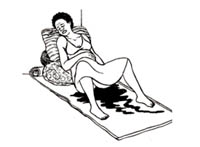What you must do for a rapid assessment
Things you need to have
- Her Antenatal Care Card (if she has been in your care previously); if she has come to you for the first time and she is already in labour, start a new health record for her
- Partograph for recording the progress of labour (you will learn how to use the partograph in Study Session 4).
- Sterile gloves
- Fetoscope to listen to the baby's heart beat
- Thermometer to take the mother's temperature
- Watch or other timer to help you measure the fetal heart rate and the mother's pulse rate
- Blood pressure measuring cuff with stethoscope
- Swabs (3-4 balls of gauze soaked with antiseptic solution such as savlon (chlorhexidene 2-4%) to clean the perineum before doing a vaginal examination. You can prepare warm water and soap if you have no antiseptic solution.
Never use alcohol to swab the genital area!
Sometimes a woman may come to you at the Health Post already in the second stage of labour. In this case, take her to the delivery couch immediately and make her as comfortable as possible. If you are seeing her at home, select an appropriate place and make it as clean and safe as you can in the available time. It is important to prepare in advance the equipment you will need for attending a delivery and keep it packed and ready at all times in case you are called to a woman who is close to giving birth.
The equipment for attending a normal delivery is described in Study Session 3.
Check her vital signs
- Blood pressure: normal values range between 90/60 mmHg to below 140/90 mmHg.
- Maternal pulse rate: normal range is 80-100 beats/minute, but should not be greater than 110 beats/minute in a woman in labour.
- Temperature: average 37oC; if it is between 37.5-38.4oC the woman has a low grade fever; if it is 38.5oC or above, she has a high grade fever.
You learned how to start IV fluids in Study Session 22 of the Antenatal Care Module and your practical skills training.
If one or more of these vitals signs is outside of the normal range, you should refer her immediately (Figure 2.1). If the values deviate a long way outside the normal range (and you have been trained to do so), refer her after you have begun an infusion of intravenous (IV) fluids.

Look at and listen to the woman
- Did someone carry her into the Health Post?
- Is there blood on her clothing or on the floor beneath her (Figure 2.2)?
- Is she grunting, moaning, or bearing down?

Ask her, or someone who is with her, whether she has now or has recently had:
- Vaginal bleeding
- Severe headache/blurred vision
- Convulsions or loss of consciousness
- Difficulty breathing
- Fever
- Severe abdominal pain
- Premature leakage of amniotic fluid (waters breaking early).
If the woman currently has any of these symptoms, immediately:
- Shout for help
- Stay calm and focus on the woman
- Stay with her — do not leave her alone
- Take immediate action to give the necessary pre-referral treatments and refer her urgently to the nearest hospital or health centre.
Management of complicated labours is covered in detail in Study Sessions 8-11 of this Module, including referral procedures and what to do on the journey to the health facility.